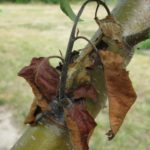Fire blight seems to have established itself in many orchards throughout the state, meaning it can still be a huge threat in the event of trauma, like hail, due to secondary spread. Secondary spread develops when stormy weather, especially hailstorms, occurs after the primary (blossom) infections. The amount of fire blight that develops after severe weather appears to be directly related to the amount of disease in the orchard, with inoculum levels highest near infected blossoms, cankers, or blighted shoots that were not previously removed. It is difficult to understand the numbers involved in fire blight—but a single droplet of ooze (Fig.1) can contain 10 to 100 BILLION bacteria. That’s a lot of possible fire blight, people!
Fire blight infections start primarily at the flowers, although bacteria can enter and establish through wounds caused by hail or high winds associated with summer storms (referred to as shoot blight or trauma blight. Note: Shoot blight is often the result of carryover flower infections from the previous year). The degree the bacteria spread has a lot to do with type of cultivar infected: Red Delicious, Honeycrisp, McIntosh, and Empire are more resistant to fire blight, compared to cultivars like Crispin(Mutsu), Fuji, Gala, Ginger Gold, Gravenstein, Jonathan, Ida Red, and Lodi that are much more susceptible. These susceptible cultivars serve as reservoirs for the bacteria. At our research plot at Meigs, we have witnessed a severe outbreak of fire blight in the Fuji/Gala/Jonathan/Ruby Jon planting—a ground zero of sorts. This block of super susceptible cultivars acted as a source of inoculum for other cultivars, quickly spreading throughout the block, and then radiating out to those trees adjacent to or downwind from the Fuji/Gala/Jonathan/Ruby Jon planting.
Dealing with shoot blight is stressful, because there are no truly effective treatments; adding to the stress and frustration is the fact that new strikes may keep appearing all summer. This leaves the grower with the question: To cut or not to cut? In Michigan, in 2000, during the big fire blight epidemic, some apple growers pruned out fire blight infections and strikes as they appeared. Other growers left the fire blight strikes until winter before pruning. Regardless of when they pruned, both found some fire blight in their orchards the following season. I think this is an important point to make—that there is no silver bullet.
Dave Rosenberger of Cornell has suggested a type of fire blight triage when it comes to making a pruning decision once blight has struck, going from highest to lowest priority. This is a great approach, so I’ve expanded upon this:
- Young orchards (less than 8 years old) with few strikes should be pruned out as soon as they appear. Failure to do so increases the likelihood that blight will continue to spread both to adjacent trees and possibly into the rootstocks of affected trees.
- Young orchards (3-8 years old) with severe strikes. Take out trees, if necessary.
- Older orchards with a few strikes. Pruning out infections in mature trees may not be practical, but mature trees with a full crop will set terminal shoot buds earlier than young trees. When trees set terminal buds, blight stops spreading both between trees and within the affected trees. Under dry conditions when only a few strikes occur, pruning to the previous year’s growth (the non-infected 2-year-old wood) should limit spread and reduce inoculum. This strategy also works when infections are few or is limited in location (one block or area of the orchard).
- DNR- Definitely Need to Remove! Okay, a bad triage pun, but this is group you prune at ground level– – trees with so many strikes that most of the tree would need to be removed. In this instance, severe pruning can stimulate new growth that can become re-infected, thereby increasing and not removing inoculum!
Trees should be examined two or three times weekly until either the epidemic slows or tree growth slows (which will slow the epidemic).
One final note: Streptomycin or other antibiotic sprays should NOT be applied during summer because summer applications can result in rapid development streptomycin-resistant strains of the blight pathogen.
- Fire blight overwinters in canker
- Fire blight removal often requires more extensive pruning than most growers realize
- Current season fire blight symptoms include blossom blight or trauma blight from recent hail storms


